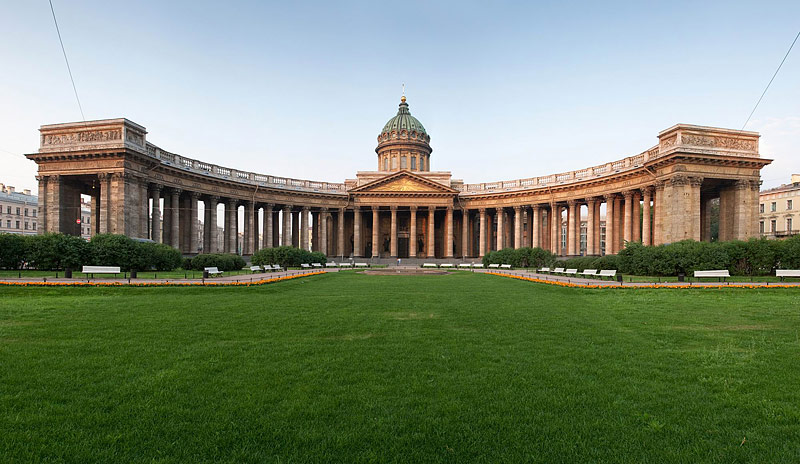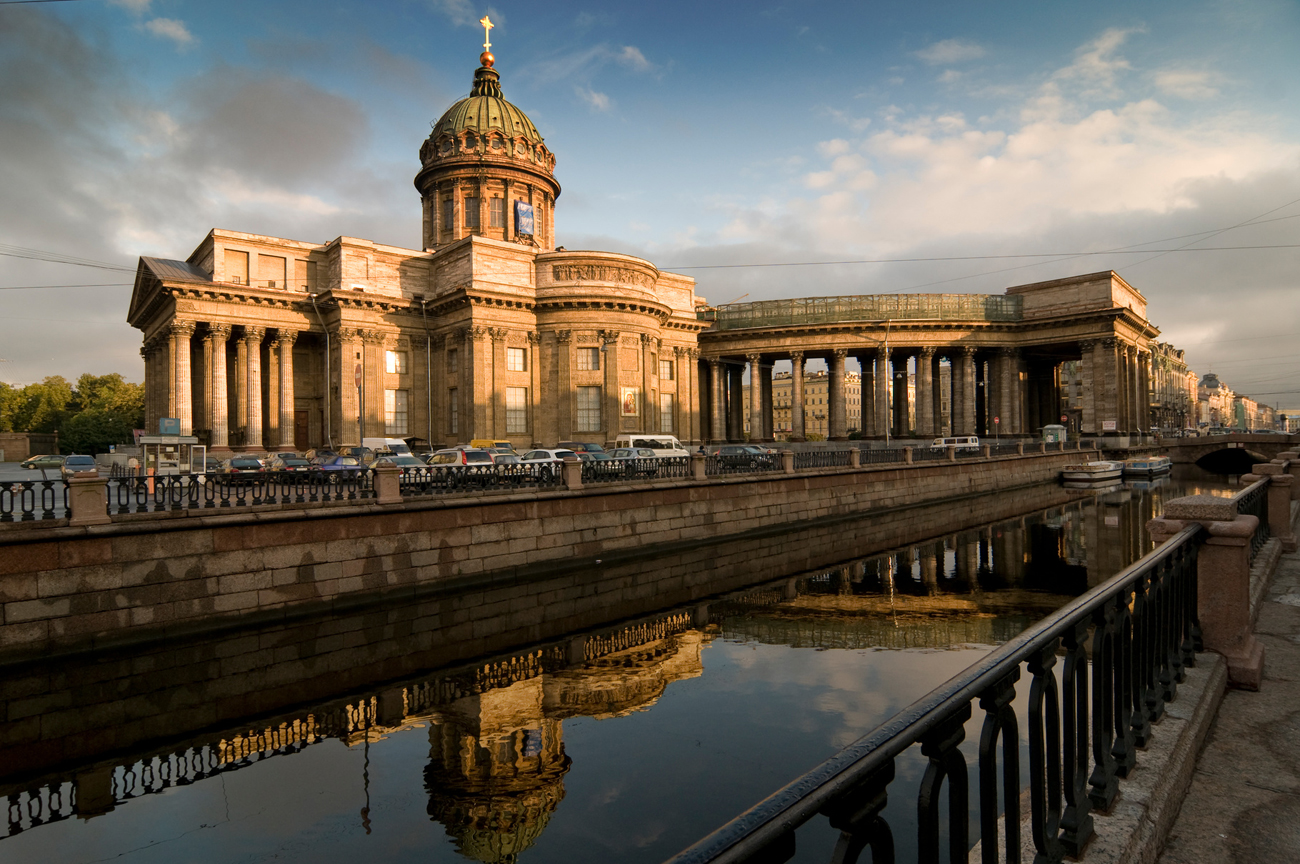казанский собор на английском языке
Казанский собор в Санкт-Петербурге (Kazan Cathedral in St Petersburg)
The Kazan Cathedral – a masterpiece of the early 19th-century Russian architecture – was built by Andrei Voronikhin. The building of the Kazan Cathedral was completed in 1811 and took ten years. The cathedral stands with its north façade facing Nevsky Prospect. On either side of the building runs a monumental semicircular colonnade of 96 Corinthian columns the outside wings of which end in grandiose portals. The southern and western entrances to the cathedral are similarly ornamented with six columned porticoes with pediments and approached by broad staircases. The huge windows in the building and the fine semicircular colonnade lend the whole edifice a restrained monumental character together with an unusual impression of lightness.
The cathedral layout is in the form of a Roman cross. The cylindrical drum in the centre with its sixteen rectangular windows and its beautiful light cupola serves as the main vertical of the building and at the same time the central axis of the whole ensemble. The cupola which is 17 m in diameter was the first in the history of world architecture to be made of metal. The brick walls are faced in stone. This stone has also been used for all the exterior columns, pilasters, capitals and balustrades and for all the exterior bas-reliefs and ornamentation.
The internal ornamentation of the cathedral is sumptuous and impressive. Particularly fine are the 56 monolithic columns of pink Finnish granite and the mosaic floor of coloured marble. The Kazan Cathedral is a unique monument to the Patriotic War of 1812. It was here that great Mikhail Kutuzov was buried in 1813.
Перевод
Внутреннее убранство собора роскошно и впечатляюще. Особенно хороши 56 монолитных колонн из розового финского гранита и мозаичный пол из цветного мрамора. Казанский собор является уникальным памятником Отечественной войны 1812 года. Именно здесь был похоронен великий Михаил Кутузов в 1813 году.
Kazansky Cathedral
Kazansky Cathedral (Cathedral of Our Lady of Kazan) designed and erected in 1801-1811 by the architect Andrei Voronikhin. The architect has created a magnificent edifice (height-71.6 m, length72.5 m). with its main building facing onto Nevsky Avenue. The cathedral with its semicircular Corinthian colonnade (96 thirteen-metre-high columns) is the dominant feature in one of the most elegant squares of the city.
Huge bas-reliefs, approximately 15 metres long and almost two metres high, depicting Biblical subjects, grace the two butt-ends of the building facing onto Nevsky Avenue. The bas-relief above the left butt-end of the building was executed by the famous Russian sculptor Ivan Martos on the subject Moses Parting the Waters, the one above the right butt-end is a depiction of the Brazen Serpent by the sculptor Ivan Prokofyev.
In the niches of the northern portico (facing onto Nevsky Avenue) bronze sculptures have been mounted: Prince Vladimir (in the period of his rule in Kiev, in approximately 988, when Christianity was adopted in Russia)-sculptor Stepan Pimenov; John the Baptist-sculptor Ivan Martos; Alexander Nevskysculptor Stepan Pimenov; and St. Andrew-sculptor Vasily Demut-Malinovsky. The bronze doors of the northern portico, consisting of ten multifigured compositions taken from the Bible are particularly worthy of attention. This is an exact copy of the doors created in the mid-15th century by the Italian sculptor Lorenzo Giberti for the Florentine Baptistery. It took Giberti 27 years to create his work of art. Michelangelo said of these doors that they were splendid enough to serve as the gates of paradise. Gypsum models of the doors were preserved in 5t. Petersburg in the Academy of Arts and from them the founder Vasily Yekimov made the doors for the Kazansky Cathedral.
After Russia’s victory over Napoleon in 1812 the cathedral became a unique monument to Russian military glory. The standards taken as trophies and the keys from the fortresses captured by the Russian forces were displayed here. In the vault of the northern chapel by the wall (to the right of the entrance) lies the grave of Mikhail Kutuzov, the commander of the Russian forces, who died in 1813. He was buried on the spot where he prayed before he left to join his army in the field.
In 1837, when the 25th anniversary of the rout of Napoleon’s troops in Russia was celebrated, statues of Mikhail Kutuzov and Mikhail Barklai de Tolli were erected in front of the cathedral. These statues were the work of the sculptor Boris Orlovsky and the architect Vasily Stasov.
Kazan Cathedral
Whilst taking a stroll along Nevsky Prospekt you cannot fail to notice the impressive Cathedral of Our Lady of Kazan. Kazan Cathedral, constructed between 1801 and 1811 by the architect Andrei Voronikhin, was built to an enormous scale and boasts an impressive stone colonnade, encircling a small garden and central fountain. The cathedral was inspired by the Basilica of St. Peter’s in Rome and was intended to be the country’s main Orthodox Church. After the war of 1812 (during which Napoleon was defeated) the church became a monument to Russian victory. Captured enemy banners were put in the cathedral and the famous Russian Field Marshal Mikhail Kutuzov, who won the most important campaign of 1812, was buried inside the church.
The cathedral was named after the «miracle-making» icon of Our Lady of Kazan, which the church housed till the early 1930s. The Bolsheviks closed the cathedral for services in 1929, and from 1932 it housed the collections of the Museum of the History of Religion and Atheism, which displayed numerous pieces of religious art and served anti-religious propaganda purposes. A couple of years ago regular services were resumed in the cathedral, though it still shares the premises with the museum, from whose name the word «atheism» has now been omitted.
Location: 2, Nevsky Prospekt, Kazanskaya Square.
We can help you make the right choice from hundreds of St. Petersburg hotels and hostels.
SHORT-TERM APARTMENT RENTAL
Live like a local in self-catering apartments at convenient locations in St. Petersburg.
Comprehensive solutions for those who relocate to St. Petersburg to live, work or study.
Maximize your time in St. Petersburg with tours expertly tailored to your interests.
Get around in comfort with a chauffeured car or van to suit your budget and requirements.
TRANSPORT FOR GROUPS
Book a comfortable, well-maintained bus or a van with professional driver for your group.
Navigate St. Petersburg’s dining scene and find restaurants to remember.
Need tickets for the Mariinsky, the Hermitage, a football game or any event? We can help.
Get our help and advice choosing services and options to plan a prefect train journey.
Let our meeting and events experts help you organize a superb event in St. Petersburg.
We can find you a suitable interpreter for your negotiations, research or other needs.
Get translations for all purposes from recommended professional translators.
Kazan Cathedral in Moscow
KEY FACTS
The history of the Kazan Cathedral
Later, the Virgin of Kazan icon icon of the Kazan Mother of God played an important role in another pivotal moment of Russian history. Because of this icon, it was believed, the Second People’s Militia was formed in 1611–1612 during the Russo-Polish War of 1605–1618 regiment led by Kuzma Minin and Prince Dmitry Pozharsky succeeded in liberating Moscow from Polish invaders.
If the Russian history is a subject of your interest and you want to know, for example, what is the oldest church in Moscow, what are the famous monasteries around Moscow, which style of Moscow architecture you can see only in this town, you can read about it on our website page about Kremlin Moscow and “History and Architecture”.
The second birth
At the end of the 18 th century, the entire complex underwent reconstruction in the classic style. This reconstruction turned the church into a non-descript structure with a ‘boat-shaped’ configuration utterly typical for Russian churches. In this style, all elements of the ensemble are arranged in a single line. Several side-chapels were removed, followed in the early 1800s by the demolishing of the tent-roofed bell tower and replacing it with its modern version. Nonetheless, the darkest times for the cathedral were yet to come. In the 1930s, the Soviet government resolved to have it demolished. The Red Square was supposed to become a site for holding socialist ceremonies – a church standing by the entrance of the Red Square was not in keeping with the socialist agenda and the mood they wished to set.

The church, quite intimate in its appearance, is actually a complex made up of a bell tower, two side-chapels, the main church and a gallery connecting all the parts. Situated on a site which is not flat, the Kazan Cathedral has a series of wide, flat and low-lying steps leading up to it invitingly from the side of the Historical Museum. The steps terminate at the gallery, whose large windows demonstrate that it was originally designed as an open-air structure, but was glazed afterwards, mainly because of the climate.
The Romanov court church: 10 facts about the Kazan Cathedral
The Kazan Cathedral in St. Petersburg.
1. Built by Russian architect Andrei Voronikhin
Tsar Paul I thought of building the Kazan Cathedral on the spot where the old Church of the Nativity of the Holy Virgin had stood. He held a competition, in which architects from across Europe participated, including Pietro Gonzago from Italy, Charles Cameron from England and Jean-Francois Thomas de Thomon from France. The emperor had already approved Cameron’s design when Count Stroganov recommended a young Russian architect by the name of Andrei Voronikhin, who had not submitted an entry in the competition. Tsar Paul liked the design, and Voronikhin was appointed chief architect.
2. Inspired by the cathedrals of Rome and Florence

Tsar Paul wanted the new edifice to resemble the St. Peter’s Basilica in Rome. Voronikhin designed an enormous colonnade, which alluded to the Italian cathedral. The Kazan Cathedral’s 96 columns were not placed along the perimeter; rather, they opened towards Nevsky Prospect. The cathedral’s northern side became the ceremonial entrance. According to Voronikhin’s original design, another colonnade was supposed to be erected on the southern side, but the idea was later abandoned.
The northern doors were cast in bronze and modeled after the Florence Baptistery’s Gates of Paradise, crafted by Lorenzo Ghiberti. Voronikhin’s contemporaries called him a «imitator» for copying the Italian masterpieces.
3. A museum of natural stone
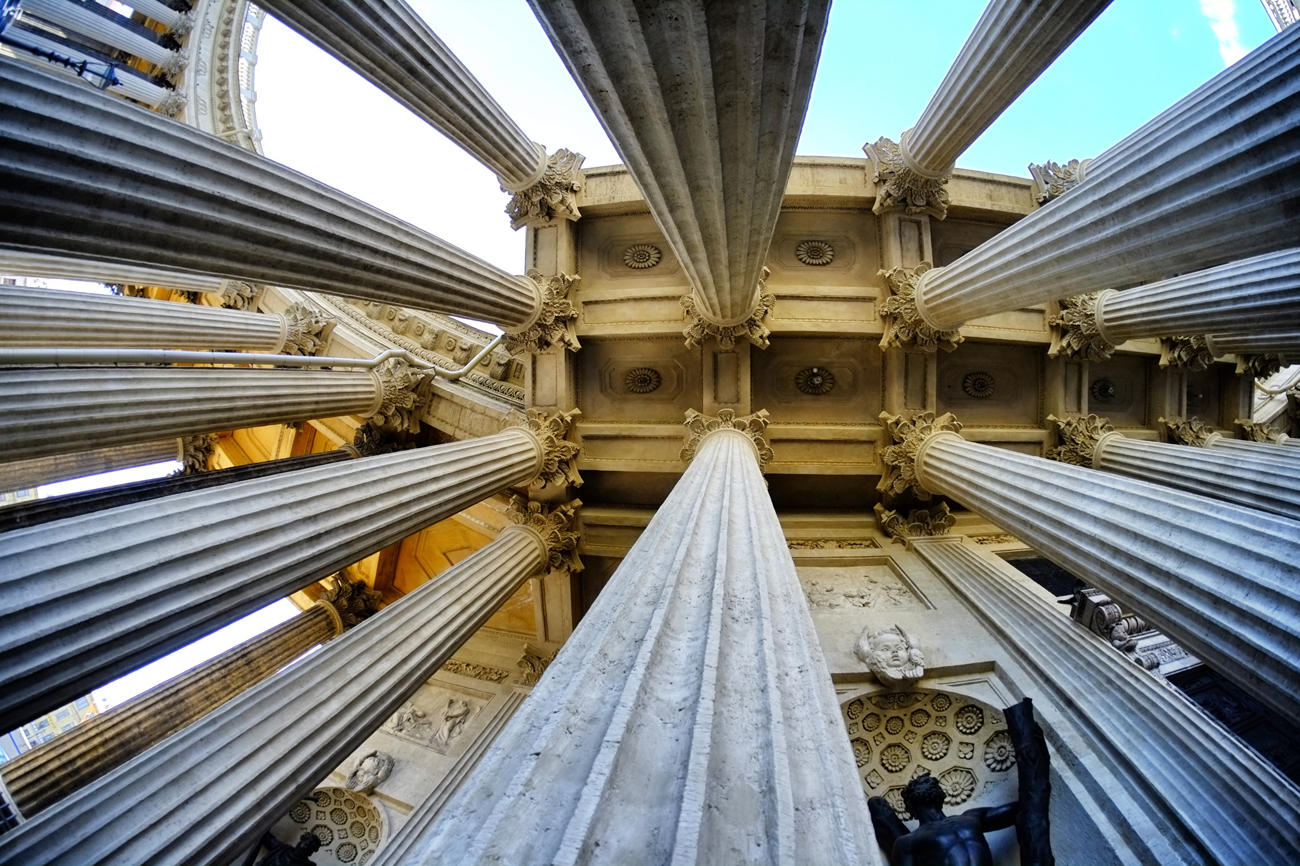
The cathedral is like a museum of Russian natural stone. The main decorative material is travertine, which was quarried not far from St. Petersburg. The stone is similar to the Italian travertine used to build St. Peter’s. Travertine, with its porous structure, can be handled easily, and was used for covering the cathedral’s external walls, for the capitals, the friezes and the casings. Inside the church, Voronikhin used Karelian marble, local porphyry and jasper. 56 pink granite columns with gilded capitals decorate the interior.
4. Leading Russian artists embellished the interior
Both the interior and external façade of the Kazan Cathedral are adorned with sculptures and bas-reliefs. Bronze statues of the saints were sculpted by Stepan Pimenov, Ivan Martos and Vasily Demut-Malinovsky. The walls are decorated with paintings created by famous artists, such as Karl Bryullov and Vladimir Borovikovsky.
5. Memorial shrine of the Franco-Russian War of 1812
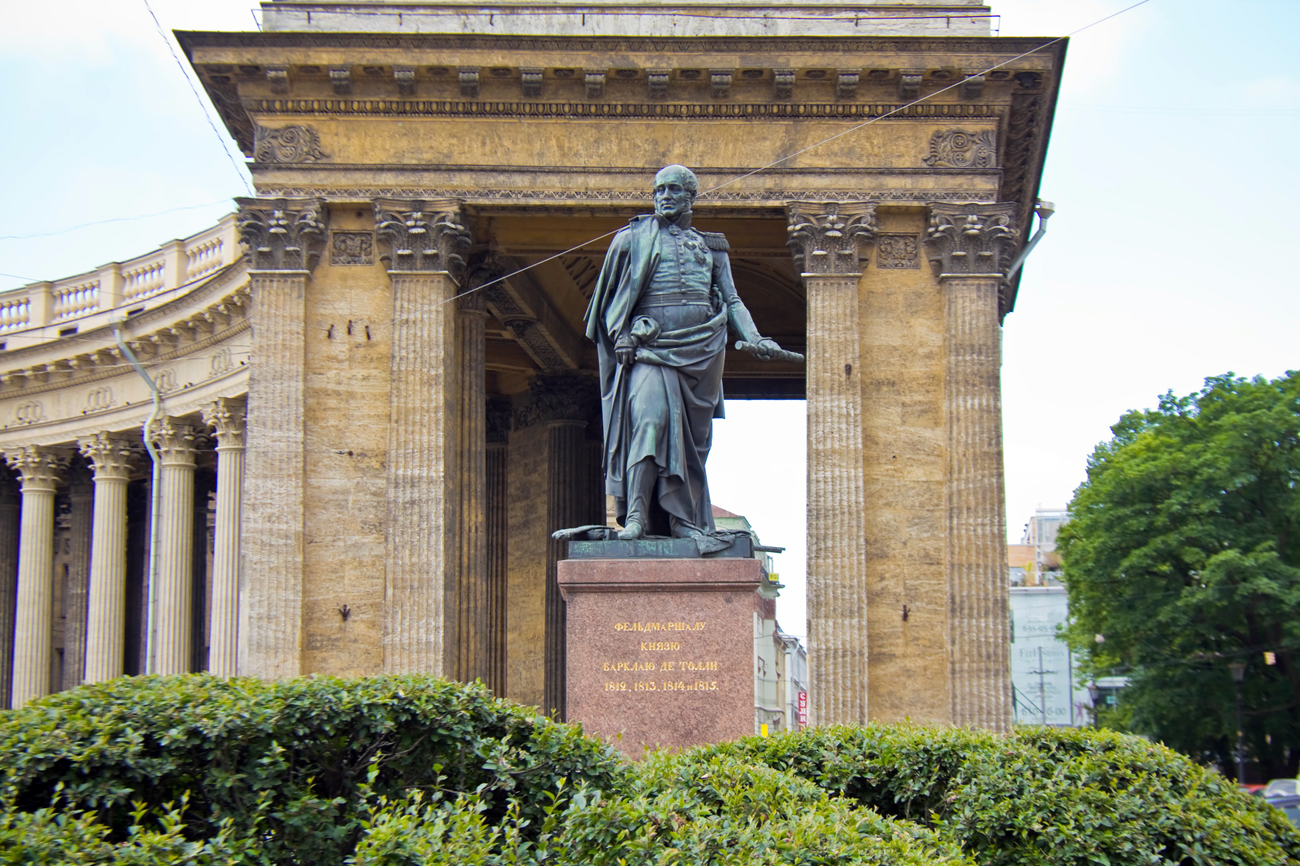
The cathedral was completed a year before the French invasion of 1812. Before leaving to join the army, commander-in-chief Mikhail Kutuzov visited a mass held in the church. After the war, trophies were brought to the cathedral, such as military banners and standards, keys from seized cities and the baton belonging to Marshal Louis-Nicolas Davout. Kutuzov himself was interred in the cathedral after his death in 1813.
6. Romanov family church
The Church of the Nativity of the Holy Virgin had been the court church of the House of Romanov. It contained a copy of the Our Lady of Kazan icon, which was the most important icon in the Russian Orthodox Church, for it protected Russia and consequently the Romanov dynasty. When the Kazan Cathedral was built, it inherited both the icon and the role of the court church. Royal family weddings, thanksgiving prayers after the unsuccessful assassination attempts on Alexander II, and the 300th anniversary of the Romanovs were all held in the cathedral.
7. The most important royal relic
The cathedral was dedicated to the Our Lady of Kazan icon, one of the most venerated Orthodox relics. It contains a copy of the icon, which is considered to work miracles. It is believed that Peter the Great ordered the relic to be brought to St. Petersburg, and before the construction of the Church of the Nativity of the Holy Virgin, the icon was housed on the Petrograd side of the city.
8. Charity centers in the cathedral
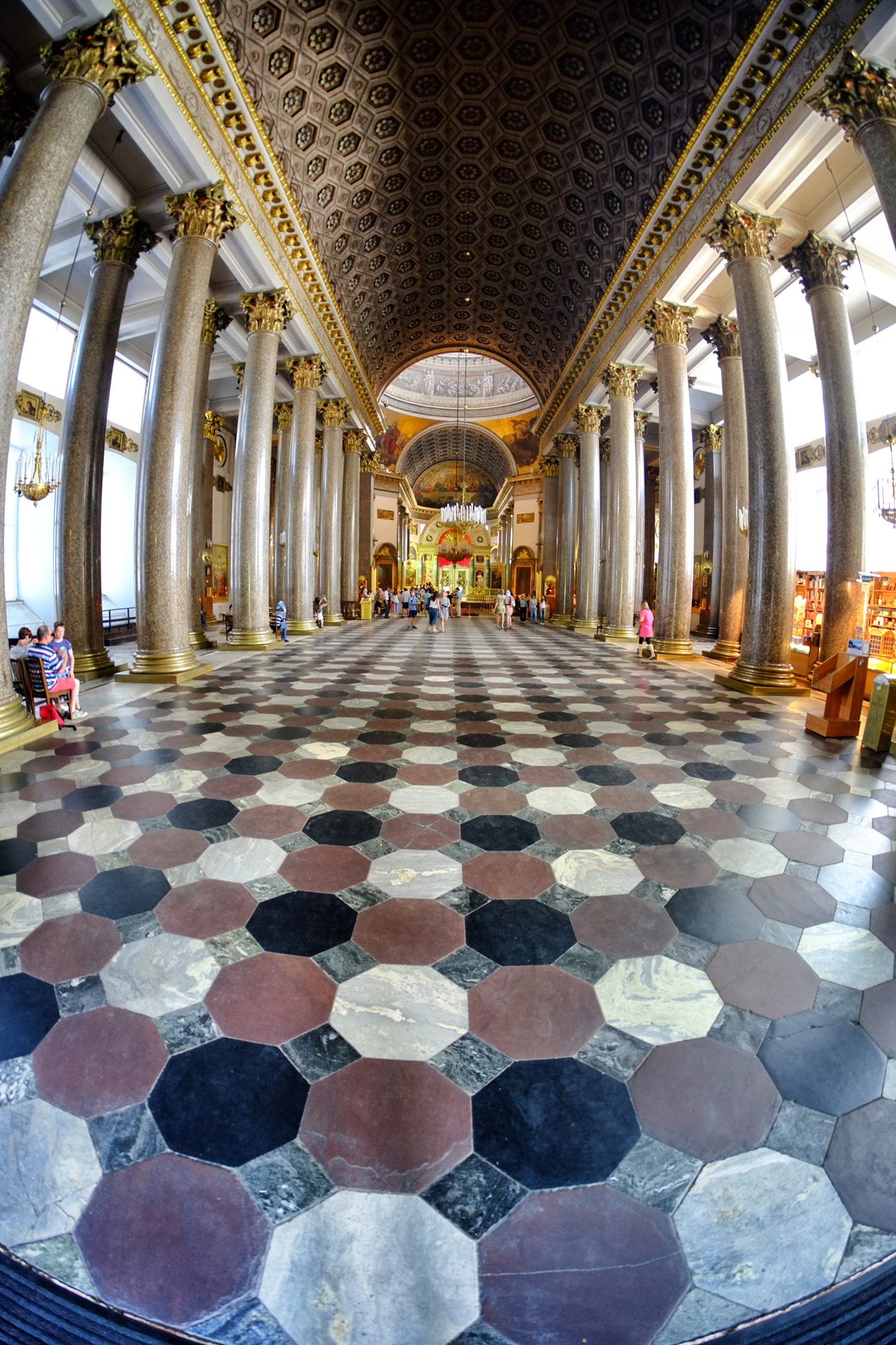
In the 19th century, a Sunday school for adults was held in the cathedral. The church also published its own newspaper and was a famous charity institution. During WWI, parishioners collected food and warm clothing to be shipped to the front. The cathedral also served as one of the first Russian field hospitals, which was founded with funds donated by the congregation. Empress Alexandra Fyodorovna was its patron.
9. Museum of the History of Religion and Atheism
In 1929, the Bolsheviks closed the cathedral and three years later gave the building to the Academy of Sciences. On the dome, a gilded globe and spire replaced the cross. All the church items were distributed among the city’s museums, and the Museum of the History of Religion and Atheism was established inside the cathedral. Its exhibits illustrated the appearance and evolution of Christianity, Islam and Eastern religions.
10. Relics hidden in the attic
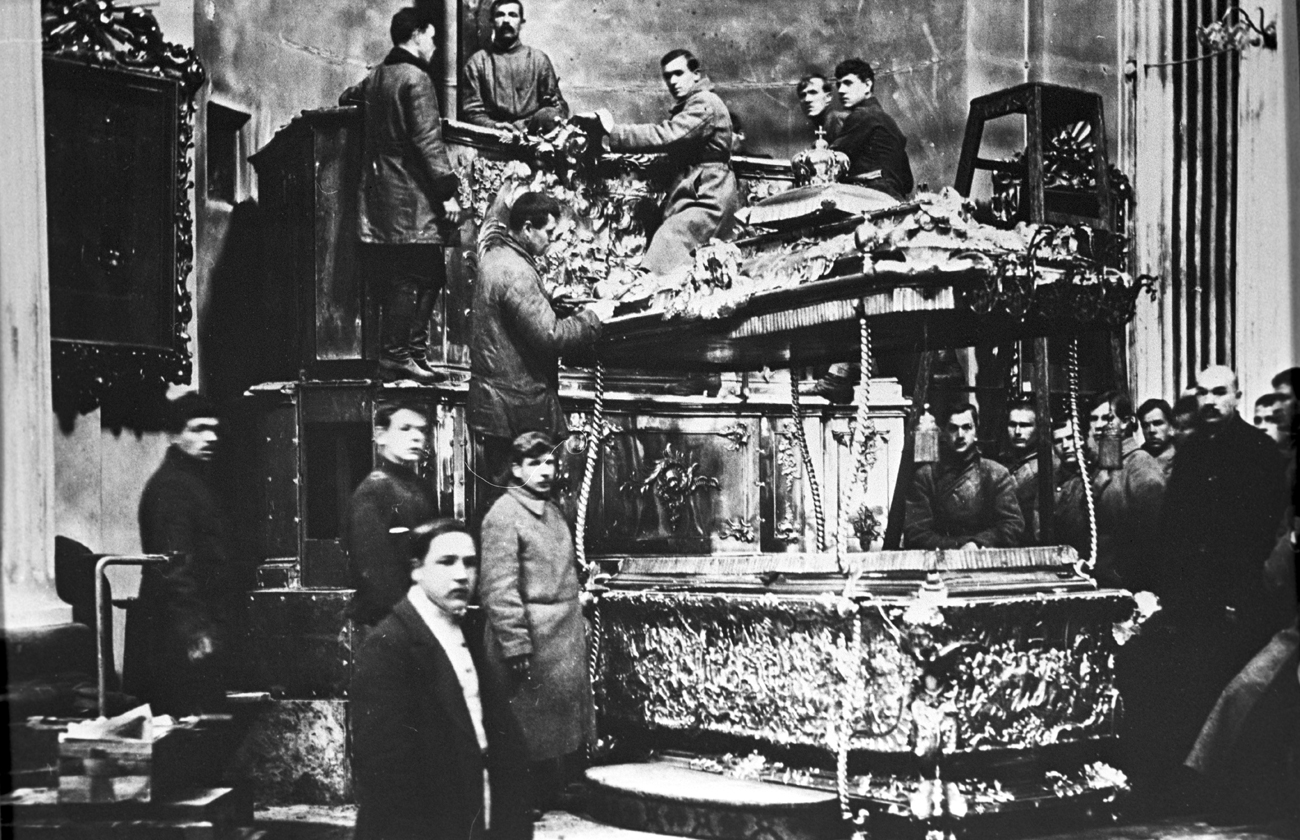
Saints’ relics that had originally lain inside the cathedral were kept in the attic for almost 20 years. Staff of the Museum of the History of Religion and Atheism had moved the relics of Saint Alexander Nevsky, Saint Zosima and others to the attic. Only in 1991 were they returned to their original places. Nevsky’s relics were transferred to the Saint Alexander Nevsky Monastery.





